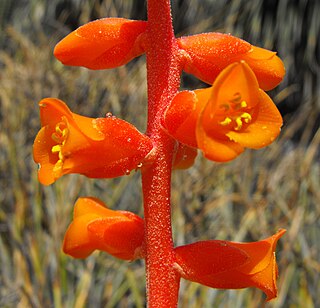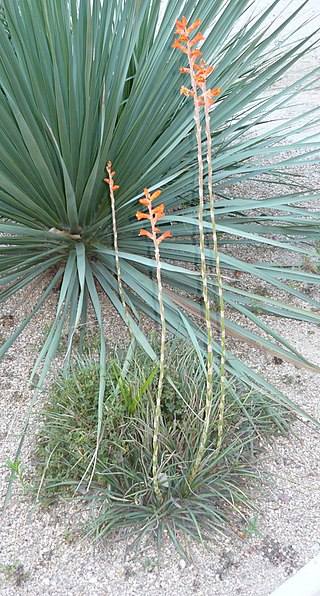
Aechmea nudicaulis is a bromeliad species in the genus Aechmea, which is often used as an ornamental plant. This species is native to Central America, the West Indies, central and southern Mexico, and northern and central South America.

Dyckia encholirioides is a plant species in the genus Dyckia. This species is endemic to Brazil.
Aechmea alba is a species of plant in the genus Aechmea. This species is endemic to Brazil.
Wittmackia burle-marxii is a species of flowering plant in the family Bromeliaceae, endemic to Brazil. It was first described in 1979 as Aechmea burle-marxii.

Aechmea comata is a species of flowering plant in the Bromeliaceae family. This species is endemic to southern Brazil.

Aechmea emmerichiae is a species of flowering plant in the genus Aechmea. This species is endemic to Chapada Diamantina National Park in eastern Brazil.

Aechmea purpureorosea is a plant species in the genus Aechmea. This species is endemic to southeastern Brazil, States of Minas Gerais and Rio de Janeiro.
Dyckia cabrerae is a plant species in the genus Dyckia. This species is endemic to Brazil.
Dyckia martinellii is a plant species in the genus Dyckia.

Dyckia pseudococcinea is a plant species in the genus Dyckia. This species is endemic to Brazil.

Vriesea racinae is a plant species in the genus Vriesea. This species is an epiphyte endemic to Brazil. known from the States of Espírito Santo and Minas Gerais.
Dyckia mezii is a species of stiff-leaved thorny plant in the genus Dyckia. This species is native to Brazil. Dyckia argentea is an illegitimate name for the same species.
Dyckia crocea is a plant species in the genus Dyckia. This species is native to Brazil.
Dyckia delicata is a plant species in the genus Dyckia. This species is native to Brazil.
Dyckia densiflora is a plant species in the genus Dyckia. This species is native to Brazil.
Dyckia dusenii is a plant species in the genus Dyckia. This species is native to Brazil.
Dyckia minarum is a plant species in the genus Dyckia. This species is native to Brazil.
Dyckia saxatilis is a plant species in the genus Dyckia. This species is native to Brazil.

Dyckia tuberosa is a plant species in the genus Dyckia. This species is native to Brazil.

Dyckia remotiflora is a plant species in the genus Dyckia. It is native to Argentina, Uruguay, and Brazil.









